Just as some sports identify rookies of the year, bibliophiles are excited to discover authors or illustrators whose debut literary works promise a bright future in the world of children’s and young adult literature. This week’s column includes reviews of some of my favorite books by debut authors of 2017.
Ages 4–8
City Moon. Rachael Cole. Ill. Blanca Gómez. 2017. Schwartz & Wade/Random House.
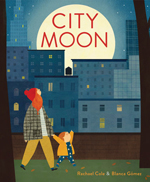 On a fall evening, a young boy and his mother go for a walk. Determined to see the moon (no easy feat in a city with tall buildings that block out the sky), he spots it in different places, even seeing its reflection in a puddle. It's almost as though the shiny orb is playing a game of hide-and-seek with them. Returning home, the boy chooses to sleep with his curtains drawn back so he can keep watching for the moon. The digitally-created illustrations handsomely depict the pair strolling hand in hand in search of the elusive moon and contain eye-catching details of the city landscape and the boy’s bedroom. Cole’s debut picture book describes perfectly the curious boy and his mother’s evening walk looking for the moon in their city neighborhood.
On a fall evening, a young boy and his mother go for a walk. Determined to see the moon (no easy feat in a city with tall buildings that block out the sky), he spots it in different places, even seeing its reflection in a puddle. It's almost as though the shiny orb is playing a game of hide-and-seek with them. Returning home, the boy chooses to sleep with his curtains drawn back so he can keep watching for the moon. The digitally-created illustrations handsomely depict the pair strolling hand in hand in search of the elusive moon and contain eye-catching details of the city landscape and the boy’s bedroom. Cole’s debut picture book describes perfectly the curious boy and his mother’s evening walk looking for the moon in their city neighborhood.
Mrs. McBee Leaves Room 3. Gretchen Brandenburg McLellan. Ill. Grace Zong. 2017. Peachtree.
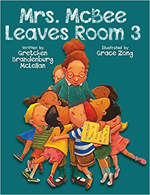 Although students might not believe it, eventually even teachers who love their jobs must say goodbye. In McLellan’s debut picture book, the dedicated Mrs. McBee finishes her last day of teaching on the final day of the school year. A consummate teacher, Mrs. McBee delivers one more lesson to her students through reminders that each one of them made the classroom special. Simple, straightforward text and expressive illustrations show how Mrs. McBee and her students find different ways of coping with change and saying farewell.
Although students might not believe it, eventually even teachers who love their jobs must say goodbye. In McLellan’s debut picture book, the dedicated Mrs. McBee finishes her last day of teaching on the final day of the school year. A consummate teacher, Mrs. McBee delivers one more lesson to her students through reminders that each one of them made the classroom special. Simple, straightforward text and expressive illustrations show how Mrs. McBee and her students find different ways of coping with change and saying farewell.
My Grandpa’s Chair. Jiyeon Pak. 2017. Knopf/Random House.
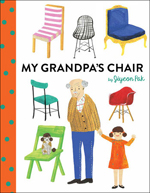 Julie's grandfather seems to have lost his zest for life and can’t even sit comfortably on his favorite couch. She takes him chair shopping, but he is unable to find anything that meets his needs in the store and decides to have one custom made. As it turns out, he’s so worried about his new chair being damaged that he puts it away instead of using it. Eventually, Julie finds the ideal sitting place for Grandpa—a tree stump in the park where there's room for him, his dog, Mimi, and her. The color-drenched, richly-detailed illustrations reveal a possible reason for Grandpa’s inability to find a happy place to sit. One of the family portraits hanging on the wall in the opening pages shows him and his wife, who does not appear elsewhere in the book. Presumably, it’s his loneliness not the chair that is the problem. This is a touching intergenerational story from a debut author-illustrator originally from South Korea.
Julie's grandfather seems to have lost his zest for life and can’t even sit comfortably on his favorite couch. She takes him chair shopping, but he is unable to find anything that meets his needs in the store and decides to have one custom made. As it turns out, he’s so worried about his new chair being damaged that he puts it away instead of using it. Eventually, Julie finds the ideal sitting place for Grandpa—a tree stump in the park where there's room for him, his dog, Mimi, and her. The color-drenched, richly-detailed illustrations reveal a possible reason for Grandpa’s inability to find a happy place to sit. One of the family portraits hanging on the wall in the opening pages shows him and his wife, who does not appear elsewhere in the book. Presumably, it’s his loneliness not the chair that is the problem. This is a touching intergenerational story from a debut author-illustrator originally from South Korea.
Ages 9–11
Almost Paradise. Corabel Shofner. 2017. Farrar, Straus and Giroux.
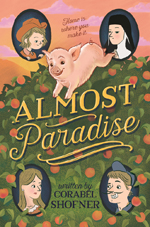 Twelve-year-old Ruby Clyde Henderson is keenly aware of her mother’s inability to make good choices. A case in point is her current boyfriend, Carl—dubbed the Catfish by Ruby Clyde—who robs a convenience store while they are heading to a new home, resulting in the arrest of him and her mother. Ruby Clyde and Bunny, her pet pig, make their way to her mother's estranged twin sister, Eleanor, who lives on an orchard in the Texas Hill Country. Even though she loves her solitary ways, Eleanor takes in Ruby Clyde. Ruby Clyde is guaranteed to steal her way into readers' hearts just as surely as she does into the hearts of Eleanor and her mother's attorney, Joe Brewer. This is a superbly-crafted debut novel, which also will have readers reaching for copies of Charles Dickens' books, especially Oliver Twist, to reread some of his immortal lines. In the end, Ruby Clyde decides she’s had enough adventure to last her a lifetime.
Twelve-year-old Ruby Clyde Henderson is keenly aware of her mother’s inability to make good choices. A case in point is her current boyfriend, Carl—dubbed the Catfish by Ruby Clyde—who robs a convenience store while they are heading to a new home, resulting in the arrest of him and her mother. Ruby Clyde and Bunny, her pet pig, make their way to her mother's estranged twin sister, Eleanor, who lives on an orchard in the Texas Hill Country. Even though she loves her solitary ways, Eleanor takes in Ruby Clyde. Ruby Clyde is guaranteed to steal her way into readers' hearts just as surely as she does into the hearts of Eleanor and her mother's attorney, Joe Brewer. This is a superbly-crafted debut novel, which also will have readers reaching for copies of Charles Dickens' books, especially Oliver Twist, to reread some of his immortal lines. In the end, Ruby Clyde decides she’s had enough adventure to last her a lifetime.
Martí’s Song for Freedom/Martí y sus versos por la libertad. Emma Othegay. Ill. Beatriz Vidal. Spanish trans. Adriana Dominguez. 2017. Children’s Book Press/Lee & Low.
 This bilingual picture book offers an introduction to Cuban freedom fighter and social activist José Martí (1853–1895). Troubled by the injustices he saw in Cuba, including slavery, Martí began writing social commentary calling for the Spanish conquerors to account for their actions. He was arrested, sentenced to hard labor in a quarry, and then exiled from his beloved island. Eventually settling in New York City, he continued to write about politics and social justice. Martí’s inspiring story is told through verses that include excerpts from his writings, offering glimpses into the life of someone determined to fight for social justice no matter the personal cost. Vidal’s beautiful gouache illustrations pay tribute to this man of words and deeds and his love of the natural world. Back matter includes an afterword, an author’s note, excerpts from Martí’s Versos Sencillos, and a selected bibliography.
This bilingual picture book offers an introduction to Cuban freedom fighter and social activist José Martí (1853–1895). Troubled by the injustices he saw in Cuba, including slavery, Martí began writing social commentary calling for the Spanish conquerors to account for their actions. He was arrested, sentenced to hard labor in a quarry, and then exiled from his beloved island. Eventually settling in New York City, he continued to write about politics and social justice. Martí’s inspiring story is told through verses that include excerpts from his writings, offering glimpses into the life of someone determined to fight for social justice no matter the personal cost. Vidal’s beautiful gouache illustrations pay tribute to this man of words and deeds and his love of the natural world. Back matter includes an afterword, an author’s note, excerpts from Martí’s Versos Sencillos, and a selected bibliography.
Take a Picture of Me, James VanDer Zee! Andrea J. Loney. Ill. Keith Mallett. 2017. Lee & Low.
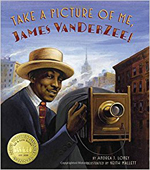 Lively text and expressive acrylic illustrations bring the Harlem Renaissance to life in this engaging biography of African American James VanDer Zee (1886–1993), a self-taught photographer. VanDer Zee grew up in Lenox, Massachusetts, where he enjoyed music and art. When he turned to photography, his work became all the rage since he captured the essence of his subjects, retouching the photographs to make them more attractive and often using backgrounds, props, and clothing to enhance the images of those who visited his shop. As times changed, VanDer Zee's services were no longer in demand since almost everyone owned cameras. VanDer Zee’s photography was featured in the Metropolitan Museum of Art's Harlem on My Mind exhibit in 1969, bringing a renewed attention to his work. The afterword of this Lee & Low New Voices Award picture book showcases some of VanDer Zee’s work and provides an example of how retouching a portrait of a woman showed her in a more flattering light.
Lively text and expressive acrylic illustrations bring the Harlem Renaissance to life in this engaging biography of African American James VanDer Zee (1886–1993), a self-taught photographer. VanDer Zee grew up in Lenox, Massachusetts, where he enjoyed music and art. When he turned to photography, his work became all the rage since he captured the essence of his subjects, retouching the photographs to make them more attractive and often using backgrounds, props, and clothing to enhance the images of those who visited his shop. As times changed, VanDer Zee's services were no longer in demand since almost everyone owned cameras. VanDer Zee’s photography was featured in the Metropolitan Museum of Art's Harlem on My Mind exhibit in 1969, bringing a renewed attention to his work. The afterword of this Lee & Low New Voices Award picture book showcases some of VanDer Zee’s work and provides an example of how retouching a portrait of a woman showed her in a more flattering light.
Ages 12–14
The Epic Crush of Genie Lo. F. C. Yee. 2017. Abrams.
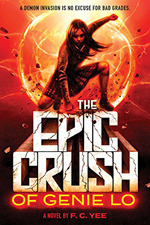 Junior Genie Lo attends a competitive San Francisco Bay Area high school where most of her classmates study hard and dream of leaving the area. Genie plays volleyball and is heavily involved with extracurricular activities to make herself a more attractive candidate for colleges. When a strange new student, Quentin, arrives, Genie can hardly believe that he is the Monkey King of Chinese folklore and is looking for her. Readers will enjoy watching the relationship between the two of them develop as well as seeing Genie gain confidence, sort out her priorities, deal with her mother and father, and fight off the demons that are suddenly plaguing her California suburb. Fast-paced action is offset with moments of introspection as Genie is forced to decide what matters most. Ultimately, Genie epitomizes the type of kick-ass heroine promised by the book’s cover—one who uses her wits and brawn in her battles.
Junior Genie Lo attends a competitive San Francisco Bay Area high school where most of her classmates study hard and dream of leaving the area. Genie plays volleyball and is heavily involved with extracurricular activities to make herself a more attractive candidate for colleges. When a strange new student, Quentin, arrives, Genie can hardly believe that he is the Monkey King of Chinese folklore and is looking for her. Readers will enjoy watching the relationship between the two of them develop as well as seeing Genie gain confidence, sort out her priorities, deal with her mother and father, and fight off the demons that are suddenly plaguing her California suburb. Fast-paced action is offset with moments of introspection as Genie is forced to decide what matters most. Ultimately, Genie epitomizes the type of kick-ass heroine promised by the book’s cover—one who uses her wits and brawn in her battles.
Viva, Rose! 2017. Susan Krawitz. 2017. Holiday House.
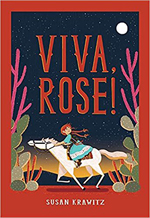 Set in El Paso, Texas, in 1915, this story follows the adventures of a most unlikely heroine: 13-year-old Rose Solomon. When Rose sees a photograph of her beloved brother Abraham in the local newspaper alongside Pancho Villa, she realizes that something is fishy and her brother is not where their parents think he is. Her plan to send a letter to him is thwarted, and Rose is kidnapped and taken to the revolutionary leader's camp where she comes to the attention of Villa’s spoiled daughter, Dorotea, who chooses Rose as her playmate. Judging by how the girl treats her dog, Pico, readers will be worried for outspoken Rose. Once Rose is reunited with her brother, she learns that he is playing a dangerous game that could cost him his life. Rose manages to pull off her escape, and returns home a stronger, wiser person.
Set in El Paso, Texas, in 1915, this story follows the adventures of a most unlikely heroine: 13-year-old Rose Solomon. When Rose sees a photograph of her beloved brother Abraham in the local newspaper alongside Pancho Villa, she realizes that something is fishy and her brother is not where their parents think he is. Her plan to send a letter to him is thwarted, and Rose is kidnapped and taken to the revolutionary leader's camp where she comes to the attention of Villa’s spoiled daughter, Dorotea, who chooses Rose as her playmate. Judging by how the girl treats her dog, Pico, readers will be worried for outspoken Rose. Once Rose is reunited with her brother, she learns that he is playing a dangerous game that could cost him his life. Rose manages to pull off her escape, and returns home a stronger, wiser person.
Ages 15+
The Hate U Give. Angie Thomas. 2017. Balzer + Bray/HarperCollins.
 Although 16-year-old Starr Carter still lives in Garden Heights, where her father runs a small grocery store, she feels disconnected from her former classmates because her parents have opted to send her to a prep school in the suburbs instead of the local public high school. Starr hides part of her identity from her new friends, including a white boyfriend, and she works hard to keep her two worlds from colliding. When she and a long-time friend Khalil run into each other at a neighborhood party and go for a ride, a police officer shoots him right in front of her. Starr must find the courage to tell the truth about what happened and defend her friend's character, no matter what the cost may be to her or her family. Delivering a knock-out punch concerning social justice while simultaneously exploring identity, race, prejudice, and family, Thomas’s debut novel paints an emotionally-riveting portrait of what it can be like to be African American in this country. At the novel’s conclusion, readers will surely be emotionally wrung out but hopeful, having come to care deeply about many of the characters.
Although 16-year-old Starr Carter still lives in Garden Heights, where her father runs a small grocery store, she feels disconnected from her former classmates because her parents have opted to send her to a prep school in the suburbs instead of the local public high school. Starr hides part of her identity from her new friends, including a white boyfriend, and she works hard to keep her two worlds from colliding. When she and a long-time friend Khalil run into each other at a neighborhood party and go for a ride, a police officer shoots him right in front of her. Starr must find the courage to tell the truth about what happened and defend her friend's character, no matter what the cost may be to her or her family. Delivering a knock-out punch concerning social justice while simultaneously exploring identity, race, prejudice, and family, Thomas’s debut novel paints an emotionally-riveting portrait of what it can be like to be African American in this country. At the novel’s conclusion, readers will surely be emotionally wrung out but hopeful, having come to care deeply about many of the characters.
A List of Cages. Robin Roe. 2017. Hyperion.
 Senior Adam Blake faces plenty of challenges due to his ADHD, but he's coping well. When he starts working as an aide to the school psychologist, Dr. Whitlock, he realizes that a student whose absentees concern the psychologist is Julian, his former foster brother. The boys reconnect, and Adam realizes that he had no idea just how much Julian has had to endure or the lengths to which his Uncle Russell will go to keep what happens at home a secret. This is a haunting, unforgettable debut novel featuring two characters with abundant courage and resilience. Readers will follow the hints that something is awry from the opening pages, but will be unable to imagine just how wrong things are.
Senior Adam Blake faces plenty of challenges due to his ADHD, but he's coping well. When he starts working as an aide to the school psychologist, Dr. Whitlock, he realizes that a student whose absentees concern the psychologist is Julian, his former foster brother. The boys reconnect, and Adam realizes that he had no idea just how much Julian has had to endure or the lengths to which his Uncle Russell will go to keep what happens at home a secret. This is a haunting, unforgettable debut novel featuring two characters with abundant courage and resilience. Readers will follow the hints that something is awry from the opening pages, but will be unable to imagine just how wrong things are.
What I Lost. Alexandra Ballard. 2017. Farrar, Straus and Giroux.
 Sixteen-year-old Elizabeth Barnes has reached her goal of losing 40 pounds, but her body image is out of whack. She still thinks her skeletal frame is covered with fat. As the book begins, Elizabeth is being admitted to a treatment facility for girls with eating disorders, but she has no plans to get well or gain weight. Instead, she figures she’ll eat just enough to be released, and then return to her old habits. Through therapy, soul-searching, and constant monitoring of her food intake by the staff, Elizabeth comes to realize all that she has lost through her self-destructive behavior. In the end, Elizabeth must save herself, bite by bite and meal by meal. Through making healthier choices and no longer dropping pounds, she finds her true self.
Sixteen-year-old Elizabeth Barnes has reached her goal of losing 40 pounds, but her body image is out of whack. She still thinks her skeletal frame is covered with fat. As the book begins, Elizabeth is being admitted to a treatment facility for girls with eating disorders, but she has no plans to get well or gain weight. Instead, she figures she’ll eat just enough to be released, and then return to her old habits. Through therapy, soul-searching, and constant monitoring of her food intake by the staff, Elizabeth comes to realize all that she has lost through her self-destructive behavior. In the end, Elizabeth must save herself, bite by bite and meal by meal. Through making healthier choices and no longer dropping pounds, she finds her true self.
Barbara A. Ward teaches graduate and undergraduate courses in literacy at Washington State University, Pullman. She spent 25 years teaching in the public schools of New Orleans, where she worked with students at every grade level, from kindergarten through high school, as well as several ability levels. She is certified in elementary education, English education, and gifted education. She holds a bachelor's in Communications and a master's in English Education from the University of Tennessee and a PhD in Curriculum and Instruction from the University of New Orleans.
These reviews are submitted by members of the International Literacy Association's Children's Literature and Reading Special Interest Group (CL/R SIG) and are published weekly on Literacy Daily.